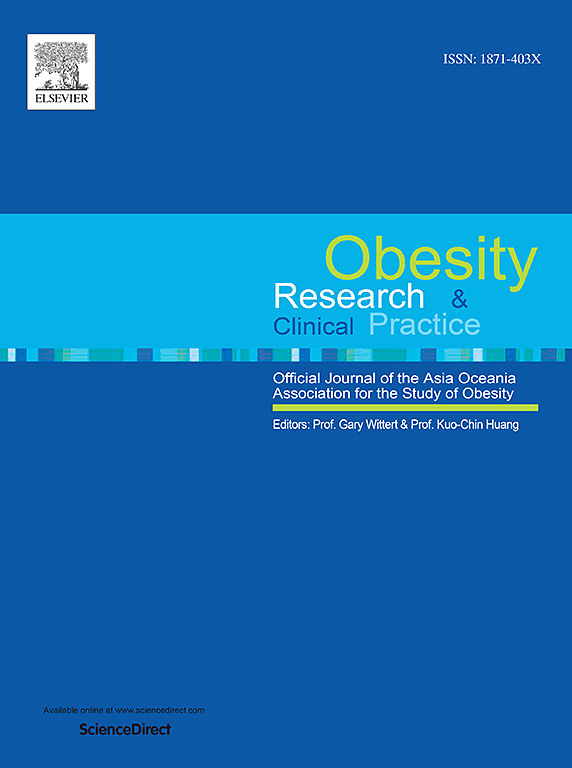Abdominal obesity and CKD: A potential mediating role of serum metabolites in the UK Biobank population
IF 2.5
4区 医学
Q3 ENDOCRINOLOGY & METABOLISM
引用次数: 0
Abstract
Background
It is generally known that although a connection between abdominal obesity and chronic kidney disease (CKD) is well-established, there is a lack of systematic research investigating the specific roles of serum metabolites, including lipid metabolites, amino acid metabolites, carbohydrate metabolites and inflammatory substances in explaining this associations.
Methods
We included 118,020 general patients with data of serum metabolites from UK Biobank. We defined abdominal obesity and CKD based on waist circumference and ICD-10 criteria. The serum metabolites were assessed by a high-throughput nuclear magnetic resonance (NMR) based metabolic biomarker profiling platform. We conducted mediation analysis by R software and used the proportion of mediation to quantify the mediation effect.
Results
This study demonstrated that lipid metabolites played a more important role in mediating the relationship between abdominal obesity and CKD than amino acid metabolites and carbohydrate metabolites. And Glycoprotein Acetyls (GlycA) was the strongest mediator for the correlation between abdominal obesity and CKD, accounting for 26.4 %. And In the mediation analysis stratified by sex, we found that the mediating effects of lipid metabolites were mostly higher in men than in women, while GlycA accounted for the largest proportion of the mediation association in both two groups (31.0 % for women and 19.8 % for men).
Conclusion
Among lipid metabolites, amino acid metabolites, carbohydrate metabolites and inflammatory substances, our study showed that infammation marker GlycA was the novel and key mediator for the correlation between abdominal obesity and CKD.
腹部肥胖与慢性肾脏病:英国生物库人群血清代谢物的潜在中介作用。
背景众所周知,虽然腹部肥胖与慢性肾脏病(CKD)之间的联系已得到证实,但目前还缺乏系统的研究来探讨血清代谢物(包括脂质代谢物、氨基酸代谢物、碳水化合物代谢物和炎症物质)在解释这种关联方面的具体作用。我们根据腰围和 ICD-10 标准定义了腹型肥胖和 CKD。血清代谢物由基于高通量核磁共振(NMR)的代谢生物标记分析平台进行评估。结果本研究表明,脂质代谢物在腹型肥胖与 CKD 关系中的中介作用比氨基酸代谢物和碳水化合物代谢物更重要。糖蛋白乙酰(GlycA)是腹部肥胖与慢性肾脏病之间相关性最强的中介因子,占 26.4%。在按性别分层的中介分析中,我们发现脂质代谢物的中介效应在男性中大多高于女性,而糖蛋白乙酰(GlycA)在两组中介关联中所占比例最大(女性为 31.0%,男性为 19.8%)。结论在脂质代谢物、氨基酸代谢物、碳水化合物代谢物和炎症物质中,我们的研究表明炎症标志物 GlycA 是腹型肥胖与 CKD 相关性的新的关键中介因子。
本文章由计算机程序翻译,如有差异,请以英文原文为准。
求助全文
约1分钟内获得全文
求助全文
来源期刊

Obesity research & clinical practice
医学-内分泌学与代谢
CiteScore
7.10
自引率
0.00%
发文量
80
审稿时长
49 days
期刊介绍:
The aim of Obesity Research & Clinical Practice (ORCP) is to publish high quality clinical and basic research relating to the epidemiology, mechanism, complications and treatment of obesity and the complication of obesity. Studies relating to the Asia Oceania region are particularly welcome, given the increasing burden of obesity in Asia Pacific, compounded by specific regional population-based and genetic issues, and the devastating personal and economic consequences. The journal aims to expose health care practitioners, clinical researchers, basic scientists, epidemiologists, and public health officials in the region to all areas of obesity research and practice. In addition to original research the ORCP publishes reviews, patient reports, short communications, and letters to the editor (including comments on published papers). The proceedings and abstracts of the Annual Meeting of the Asia Oceania Association for the Study of Obesity is published as a supplement each year.
 求助内容:
求助内容: 应助结果提醒方式:
应助结果提醒方式:


